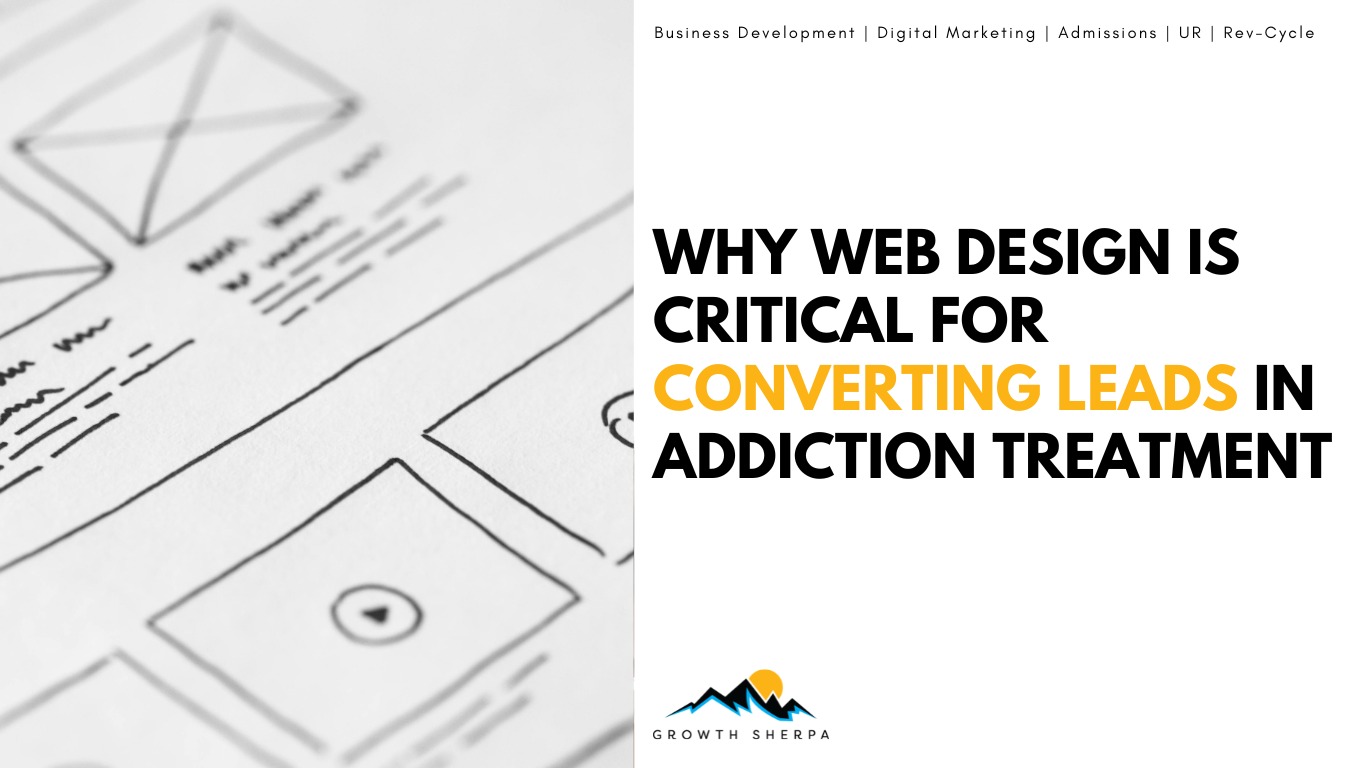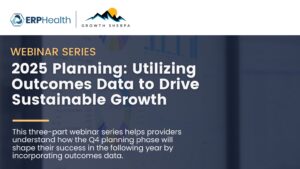The effectiveness of an addiction treatment provider’s website goes far beyond aesthetics. For behavioral health and addiction treatment facilities, a well-designed website is not just a luxury—it’s a necessity. An engaging, user-friendly, and SEO-optimized website can make a significant difference in lead conversion, helping treatment providers reach those who need support in their recovery journey. This article will explore why web design is crucial for lead conversion, focusing on how web design impacts SEO and, ultimately, enhances your facility’s online presence.
Understanding Web Design’s Role in Lead Conversion
For addiction treatment providers, every website visitor could represent someone in immediate need of assistance. Given the highly sensitive nature of the services offered, a poorly designed website can create barriers for individuals seeking help. When a website isn’t optimized for usability, speed, or visual appeal, visitors may feel alienated, lose trust, or fail to find the information they need—all of which can deter them from reaching out. Here’s why a strong website design is integral for turning visitors into leads:
- First Impressions Matter: Research shows that visitors form an opinion about a website within 0.05 seconds. For addiction treatment providers, it’s essential to create a sense of trust and credibility immediately. A clean, professional design with consistent branding can signal to visitors that they’ve found a reliable source of support.
- Easy Navigation Enhances User Experience: Many website visitors are overwhelmed with options and might be feeling anxious as they search for help. Simple, intuitive navigation can guide them through your services, locations, and treatment options, increasing the likelihood that they’ll stay on the page and take the next step toward contacting your facility.
- Responsive Design for All Devices: A large percentage of people seeking addiction treatment services use mobile devices to browse the web. A website that’s not mobile-friendly can frustrate users, causing them to abandon the site. Responsive design ensures that the user experience is seamless across devices, improving the chance that visitors will stay, read, and ultimately reach out.
- SEO and Lead Conversion are Interlinked: Search engine optimization (SEO) impacts how easily people can find your site in search engines, and web design plays a critical role in SEO. The way your site is designed—its structure, speed, mobile compatibility, and more—affects your SEO rankings and directly impacts the number of leads your site generates.
Key Web Design Elements for Effective Lead Conversion
1. Clean and Engaging Visuals
Visual appeal in web design goes beyond colors and images—it’s about crafting a digital experience that resonates with visitors and guides them toward taking action. Addiction treatment providers should aim to create a visually calming and welcoming environment on their websites. This is often achieved through:
- Consistent Color Schemes: Use colors that reflect empathy, professionalism, and reliability. Blues and greens, for instance, are often associated with trust and calmness.
- Professional Imagery: High-quality images, such as pictures of your facility, your team, or nature, can make your website feel more inviting and personal.
- Simple, Clear Layout: Overloading a page with too many elements can overwhelm visitors. A clean layout with clear headings and plenty of white space can enhance readability and encourage users to explore further.
2. Fast Loading Speeds
Site speed is critical for SEO and user experience alike. Google and other search engines prioritize websites that load quickly, especially on mobile devices. If your site takes more than three seconds to load, visitors are likely to leave, and your search rankings can suffer.
- Optimize Images: Compress images without sacrificing quality to reduce load times.
- Use a Reliable Hosting Provider: Your website’s hosting service can significantly impact speed, so opt for a high-quality provider.
- Reduce Excessive Plugins: Too many plugins can slow down your site. Evaluate each plugin for necessity and efficiency.
3. SEO-Optimized Design and Content
SEO is more than just keywords; it’s about building a site that search engines can understand and users can navigate easily. An SEO-optimized website design ensures that potential clients can find your treatment facility when searching for addiction treatment options in your area. Key SEO-related design elements include:
- Logical Site Structure: Your website’s structure should be simple and organized, making it easy for search engine crawlers to index your pages.
- Proper Use of Headers (H1, H2, H3): Properly structured headings not only improve readability for users but also allow search engines to understand the importance of different sections of your content.
- Internal Linking: Linking to relevant pages within your site can improve user experience and boost SEO. For example, linking from your homepage to specific treatment program pages allows users to find information quickly and signals to search engines which pages are most important.
- Meta Descriptions and Title Tags: These elements, though often overlooked, play a big role in SEO. Each page should have a unique meta description and title tag that succinctly describes its content while incorporating primary keywords.
4. User-Friendly Navigation and Clear Calls-to-Action
When someone visits your website, they should be able to find essential information—such as treatment programs, contact details, and success stories—without hassle. Effective navigation and clear calls-to-action (CTAs) can make all the difference.
- Simple Menus: Avoid cluttered menus by limiting the number of items in the main navigation bar.
- Breadcrumbs: Including breadcrumbs (small navigational aids) at the top of pages helps users keep track of their location within your site.
- Visible CTAs: Use compelling CTAs throughout the website, such as “Contact Us,” “Get Help Now,” or “Start Your Journey.” These CTAs should be easy to locate, ideally above the fold or at the end of relevant sections.
5. Accessibility and Inclusivity
For an addiction treatment website, accessibility is essential—not just for compliance but to ensure that anyone seeking help can access your information. Implementing accessibility best practices, such as adding alt text to images, ensuring contrast between text and background colors, and providing keyboard navigation options, makes your site inclusive and user-friendly.
6. Trust Signals
Trust signals, such as patient testimonials, accreditations, and success stories, can help establish credibility and encourage visitors to reach out. For addiction treatment providers, establishing trust is especially important, as potential clients may feel vulnerable or apprehensive about reaching out for help. Examples of trust-building elements include:
- Accreditation Badges: Display logos of accrediting bodies such as The Joint Commission or CARF to reassure visitors of your facility’s quality.
- Testimonials and Reviews: Client testimonials and reviews help humanize your brand and build trust.
- Privacy Policy: Include a link to your privacy policy to reassure visitors that their data is secure and confidential.
How Web Design Directly Impacts SEO for Addiction Treatment Providers
1. Mobile-Friendliness
With Google’s shift to mobile-first indexing, it’s essential that your website is mobile-friendly. A mobile-optimized site not only improves user experience but is also crucial for SEO. In addiction treatment, where users might look up services on their mobile devices during urgent situations, a seamless mobile experience is crucial.
2. User Experience Metrics
Google uses metrics like bounce rate, dwell time, and pages per session as ranking factors. If visitors quickly leave your site, it sends a negative signal to search engines. Improving user experience through a well-designed website can enhance these metrics and boost your search engine rankings.
3. Schema Markup
Schema markup (a type of microdata) helps search engines better understand your content. Adding schema to critical pages—such as your homepage, program pages, and contact page—can improve visibility on search engine results pages (SERPs). For addiction treatment providers, adding LocalBusiness or Organization schema markup is especially beneficial for local SEO.
4. Optimized Images and Alt Text
As mentioned earlier, optimized images contribute to page speed. Additionally, including descriptive alt text for images helps with SEO by giving search engines more context. This can also improve accessibility for users with visual impairments, as screen readers use alt text to describe images.
A Cohesive Digital Experience with SEO and Web Design
The success of an addiction treatment facility’s digital presence lies in the harmony between SEO and web design. By incorporating these best practices, providers can create a site that not only ranks well on search engines but also effectively converts visitors into leads. A strong, SEO-driven web design strategy not only improves search rankings but also enhances the likelihood that someone will reach out for support. The elements discussed above—clear navigation, compelling CTAs, mobile-friendliness, and trust signals—all contribute to a seamless, impactful digital experience.
Ready to Improve Your Website’s Impact?
Investing in web design may seem daunting, but the benefits are well worth it. A well-designed website doesn’t just enhance visibility—it has the potential to transform your facility’s digital presence and increase your ability to help those in need. Whether it’s through an intuitive layout, optimized SEO, or a mobile-first approach, each design choice you make can impact the experience of your future patients. For addiction treatment providers, the website is often the first point of contact for someone seeking help. When done right, it can provide a lifeline to those in need and set the stage for successful conversions and sustainable growth.




